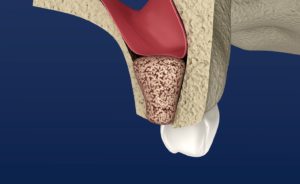 Have you decided to replace your missing teeth with dental implants? That’s great! Your first step to completing your smile involved scheduling a consultation with an implant dentist. Unfortunately, after reviewing your CT scan, your dentist determined you have lost density in your jawbone. As a result, you may not be a candidate for the treatment, but that doesn’t mean you can’t become one. Your dentist likely recommended a bone graft to strengthen your jaw. Although it adds another step to your treatment plan, here’s why a strong jawbone is crucial to the success of your new smile.
Have you decided to replace your missing teeth with dental implants? That’s great! Your first step to completing your smile involved scheduling a consultation with an implant dentist. Unfortunately, after reviewing your CT scan, your dentist determined you have lost density in your jawbone. As a result, you may not be a candidate for the treatment, but that doesn’t mean you can’t become one. Your dentist likely recommended a bone graft to strengthen your jaw. Although it adds another step to your treatment plan, here’s why a strong jawbone is crucial to the success of your new smile.
Dental Implants Require Adequate Bone
A dental implant is unlike any other treatment because it replicates the entire structure of a tooth, including the root. A titanium post is surgically placed into the jawbone to serve as a root. It will stimulate your jaw to promote bone growth through a process called osseointegration. As your mouth heals, your bone will fuse with the implant, allowing it to remain in place for a lifetime with the proper care.
It’s fairly common for patients who are interested in dental implants to require bone grafting before their placement surgery. Bone loss is associated with missing teeth. When even a single tooth is missing, the underlying bone will deteriorate because it isn’t being stimulated by the root. You can lose as much as 25% of your jawbone’s density within the first year of losing a tooth. As a result, there may not be enough bone to support the implant, which will cause it to fail.
Bone Grafting Strengthens Your Jaw
Bone grafting is a surgical procedure used to strengthen weak areas of your jaw. While under a local anesthetic or sedation, your gum tissue is opened to gain access to your jaw. Your dentist will place synthetic bone, bone from a donor, or bone from another area of your body onto your jaw. Your gum tissue is sutured closed, and your bone will integrate with the graft over the next several weeks.
It’s not uncommon for patients to need a sinus augmentation along with bone grafting. The maxillary sinuses are located on either side of the nose. If bone loss has occurred in the upper arch, there may not be enough room to place the posts without causing them to protrude into the sinuses. Your implant dentist can lift the sinuses and place a bone graft in the area to add height to the bone.
Enjoy a Sturdy Foundation
Don’t let something as simple as bone loss prevent you from completing your smile. Bone grafting is an effective solution to give your new smile the strength and stability it needs to thrive for decades.
About Dr. Joe Ornelas
Dr. Ornelas earned his dental degree at the Indiana University School of Dentistry before continuing his training in advanced studies, like dental implants. He is a member of various dental organizations due to his qualifications and career excellence, including the American Dental Association and the Indiana Dental Association. If you’re ready to treat your tooth loss, contact our office today to schedule an appointment.
